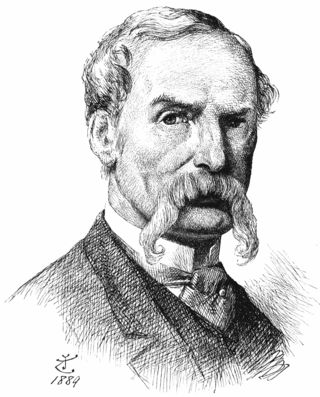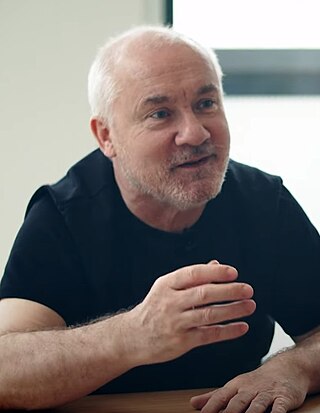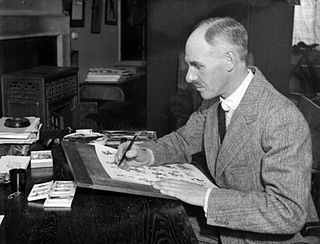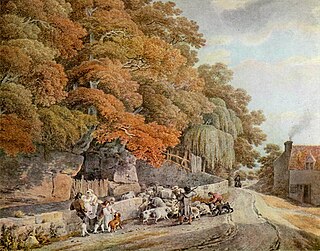Related Research Articles

Sir John Tenniel was an English illustrator, graphic humourist and political cartoonist prominent in the second half of the 19th century. An alumnus of the Royal Academy of Arts in London, he was knighted for artistic achievements in 1893, the first such honour ever bestowed on an illustrator or cartoonist.

The Young British Artists, or YBAs—also referred to as Brit artists and Britart—is a loose group of visual artists who first began to exhibit together in London in 1988. Many of the YBA artists graduated from the BA Fine Art course at Goldsmiths, in the late 1980s, whereas some from the group had trained at Royal College of Art.

Pamela Colman Smith, nicknamed "Pixie", was a British artist, illustrator, writer, publisher, and occultist. She is best-known for illustrating the Rider–Waite tarot deck for Arthur Edward Waite. This tarot deck became the standard among tarot card readers, and remains the most widely used today. Smith also illustrated over 20 books, wrote two collections of Jamaican folklore, edited two magazines, and ran the Green Sheaf Press, a small press focused on women writers.

Paul Gustave Louis Christophe Doré was a French printmaker, illustrator, painter, comics artist, caricaturist, and sculptor. He is best known for his prolific output of wood-engravings illustrating classic literature, especially those for the Vulgate Bible and Dante's Divine Comedy. These achieved great international success, and he became renowned for printmaking, although his role was normally as the designer only; at the height of his career some 40 block-cutters were employed to cut his drawings onto the wooden printing blocks, usually also signing the image.

Damien Steven Hirst is an English artist and art collector. He is one of the Young British Artists (YBAs) who dominated the art scene in the UK during the 1990s. He is reportedly the United Kingdom's richest living artist, with his wealth estimated at US$384 million in the 2020 Sunday Times Rich List. During the 1990s his career was closely linked with the collector Charles Saatchi, but increasing frictions came to a head in 2003 and the relationship ended.
Arthur Paul was an American graphic designer and the founding art director of Playboy magazine. During his time at Playboy, he commissioned illustrators and artists, including Andy Warhol, Salvador Dalí, and James Rosenquist, as part of the illustration liberation movement.

Arthur Szyk ; June 3, 1894 – September 13, 1951) was a Polish-born Jewish artist who worked primarily as a book illustrator and political artist throughout his career. Arthur Szyk was born into a prosperous middle-class Jewish family in Łódź, in the part of Poland which was under Russian rule in the 19th century. An acculturated Polish Jew, Szyk always proudly regarded himself both as a Pole and a Jew. From 1921, he lived and created his works mainly in France and Poland, and in 1937 he moved to the United Kingdom. In 1940, he settled permanently in the United States, where he was granted American citizenship in 1948.
Alan E. Cober, born in New York City was an American illustrator. His artwork appeared in The New York Times, Life, Time and numerous other publications. Cober was inducted into the Illustration Hall of Fame in 2011, thirteen years after his death in 1998. Cober was frequently cited as one of the most innovative illustrators America has ever produced.

Henry Mayo Bateman was a British humorous artist and cartoonist.

Chevalier Fortunino Matania was an Italian artist noted for his realistic portrayal of World War I trench warfare and of a wide range of historical subjects.

Gordon Frederick Browne was an English artist and a prolific illustrator of children's books in the late 19th century and early 20th century. He was a meticulous craftsman and went to a great deal of effort to ensure that his illustrations were accurate. He illustrated six or seven books a year in addition to a huge volume of magazine illustration.

Albert George Morrow was an Irish illustrator, poster designer and cartoonist.

Christopher Piers Arthur Wardle was a British artist, musician and art factotum. Born in Beckenham, he lived in Southwark, London, UK and died in Clyst Hydon, Devon, UK.

Michael Angelo Rooker was an English oil and watercolour painter of architecture and landscapes, illustrator and engraver. He was also the principal scene painter at the Haymarket Theatre.

Since their invention and subsequent proliferation in the mid-20th century, ballpoint pens have proven to be a versatile art medium for professional artists as well as amateur doodlers. Ballpoint pen artwork created over the years have been favorably compared to art created using traditional art mediums. Low cost, availability, and portability are cited by practitioners as qualities which make this common writing tool a convenient, alternative art supply.

Hugh Thomson was an British Illustrator born at Coleraine near Derry. He is best known for his pen-and-ink illustrations of works by authors such as Jane Austen, Charles Dickens, and J. M. Barrie. Thomson inaugurated the Cranford School of illustration with the publication of the 1891 Macmillan reissue of Mrs. Gaskell's Cranford.

Peter Mazell was an Irish painter and engraver, working in London between c. 1761 and 1797. He is known for his fine engravings of natural history subjects, especially those illustrating books by John Walcott and the Welsh naturalist Thomas Pennant. He created almost 600 engravings in his career. He also exhibited paintings of landscapes and flowers. He exhibited at the Society of Artists and at the Royal Academy.
Petra Štefanková is a Slovak illustrator, digital artist, designer and art director. She has worked in the animation, advertising and publishing industries.
Phil Day is an Australian artist. He is formally recognised as a Notable Graduate from the Graphic Investigation Workshop, Australian National University (ANU), alongside Alex Hamilton, Paul McDermott, Danie Mellor and Paul Uhlmann.
Isobel Dorothy Joyce Dennys was an English cartoonist, illustrator and painter. She worked for the Voluntary Aid Detachment during the First World War and designed and created recruitment posters for both it and the Women's Royal Naval Service. Dennys spent 1919 and 1921 working in Australia before returning to England in 1921. She contributed humorous illustrations in the form of sketches and strip cartoons to journals and illustrated a series of books. Dennys also published plays catered primarily for amateurs and provided the cover illustrations to many of them. She took up oil painting at age 70 and she authored her autobiography in 1983. Examples of her oil paintings are held by three museums and a blue plaque has been installed at her Budleigh Salterton home since April 2015 to commemorate her life.
References
- ↑ "Lucinda Rogers". British Museum. Retrieved 22 August 2021.
- ↑ Elgot, Jessica (3 May 2012). "Artist drawn to support restored East End shul". The Jewish Chronicle.
- ↑ "24 hours with First Hand". Eye Magazine. January 2013.
- ↑ "Drawing Out Ideas". Design Week. 12 September 2002.
- ↑ Hirst, Christopher (3 October 2008). "The Weasel: Goodbye to all that". The Independent.
- ↑ "Cook the Books by Tamasin Day-Lewis". Telegraph Book Review. 14 December 2000.
- ↑ "Read, think, relax" (PDF). The Guardian Review Section. 27 May 2006.
- ↑ "Lucinda Rogers at Ground Zero". Ambit Poetry Magazine No170. 2002.
- ↑ "Falmouth University Illustration Forum on Reportage" (PDF). Falmouth University Reportage Illustration Forum Booklet. 2014.
- ↑ "Employment Land portfolio - Drawings of Tottenham". London Architecture Diary. June 2015.
- ↑ Rachel Steven (19 October 2015). "Printing company the Baddeley Brothers celebrated in a new book designed by David Pearson". Creative Review.
- ↑ "Reportager award 2015". Reportager Award with Moleskine at UWE. 2015.
- ↑ "Frome Standard". Frome Standard Article about Industrious Exhibition. 2016.[ permanent dead link ]
- ↑ "David Chandler". Review of Industrious Exhibition by David Chandler. 2016.
- ↑ Frances Hedges (27 May 2016). "What to see: Lucinda Rogers' Restaurant Drawings". Town and Country Magazine.
- ↑ "V&A 150 Years Anniversary Album". The V&A Collections. June 2007.
- ↑ Ruth Lewis (24 April 2002). "Changing tales of two cities". The Evening Standard.
- ↑ "Lucinda Rogers: On Gentrification". House of Illustration. Retrieved 15 November 2018.
- ↑ "Lucinda Rogers draws Dalston's changing landscape in House of Illustration's fourth commission" (PDF) (Press release). House of Illustration.
- ↑ "Acclaimed reportage artist exhibits detailed study of famous concert venue". Snape Maltings. 4 October 2018. Retrieved 22 June 2018.
- ↑ "Being There". Eye . 24 June 2019.
- ↑ ISBN 191627420X, ISBN 978-1916274204
- ↑ "Lucinda Rogers". British Library. Retrieved 18 May 2020.
- ↑ "Dream Palaces". Sight and Sound Magazine. Archived from the original on 11 April 2020. Retrieved 22 June 2020.